Expertise Provided by Mark Robertson
Investing in the sector can be a move; one way to do it is through industrial ETFs. These investment vehicles allow you to track various stocks, exposing you to the sector. The best part is that these ETFs are affordable and accessible for investors of all levels, making them a great option.
This article will explore some of the top ETFs available in the market. Additionally, we will address queries about these ETFs, including their definition, the ones out there, and whether any industry-specific options are worth considering. Some best Utility ETFs are also included in it.
Given the plethora of ETFs, choosing the one might seem daunting. However, here are some standout options that you should consider;
Vanguard Industrials ETF (VIS)
The VIS is an ETF that closely follows the S&P 500 Industrial Index. It is widely recognized as one of the best ETFs available and comes with a low expense ratio of just 0.10%.
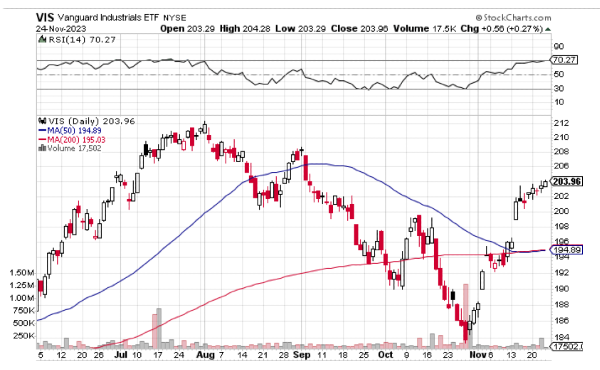 Source: Stock Charts
Source: Stock Charts
The stock chart you provided illustrates the Vanguard Industrials ETF (VIS) performance between November 23 and November 25, 2023. Starting at $203.29 on November 23, it concluded at $203.96 on November 25, showing an increase of 0.67% over the three-day period.
The stock ended the day higher than its 50-day moving average, indicating a trend. The Momentum RSI (MRSI) indicator stands at 70.27, which suggests that the stock has been relatively stable over the three days, with a value of $204.28 and a lowest value of $203.29, indicating a neutral market condition.
After analyzing the aspects of VIS, the stock will likely stay within a range shortly. If you're considering investing, it would be wise to wait for the store to surpass $204.28 or drop below $203.29 before deciding whether to buy or sell.
SPDR S&P Industrial Select Sector Fund (XLI)
XLI represents another exchange-traded fund (ETF) closely tracking the S&P Industrial Select Sector Index. It resembles VIS, albeit with an expense ratio of 0.12%.
 Source: Stock Charts
Source: Stock Charts
Upon reviewing the chart, it becomes evident that XLI maintained a trading range over three days, reaching as high as $106.54 and dipping to a low of $106.07. Interestingly, the stock concluded above its 50-day moving average, indicating an outlook. However, it remains below its 200-day moving average, signaling some sentiment. The Momentum RSI (MRSI) indicator currently stands at 71.30, surpassing the threshold of 50 but falling short of 70.
Based on analysis, XLI is in a good state for now. To decide on investing, it would be wise for investors to await either a breakthrough above $106.54 or a substantial decline below $106.07 before establishing a position.
iShares Core S&P Total US Market Industrial Index ETF (ITOT)
ITOT is an exchange-traded fund (ETF) that provides exposure to the sector by tracking the S&P Total US Market Industrial Index. This ETF comprises stocks of market capitalizations, including oversized, mid-, and small-cap companies. An attractive feature of ITOT is its expense ratio of 0.07%.
 Source: Stock Charts
Source: Stock Charts
The iShares Core S&P Total US Industrial Sector ETF (ITOT) has been experiencing a trend since the beginning of November. The 50-day and 200-day moving averages show a decline, and the Momentum RSI (MRSI) indicator is below 70. These indications suggest that the stock will continue its decline in the future. Therefore, investors should exercise caution before considering purchasing this ETF.
Fidelity MSCI Industrials Index ETF (FIDU)
FIDU is an ETF focusing on companies tracking the MSCI World Industrials Index. It comprises a range of stocks and boasts a low expense ratio of 0.08%.
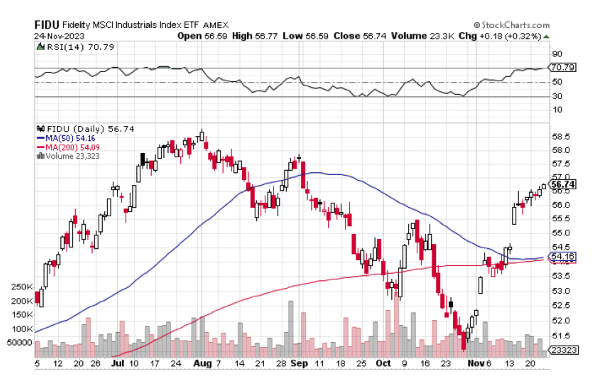 Source: Stock Charts
Source: Stock Charts
Looking at the chart, it's evident that FIDU experienced trading over ten days with a high point of $57.28 and a low point of $56.59. Notably, the stock closed above its 50-day and 200-day moving averages, indicating market sentiment. The Momentum RSI (MRSI) indicator currently stands at 70.79, surpassing the level of 50 but remaining below the level of 70.
Based on analysis, FIDU is currently following a short-term trend. Investors are advised to consider purchasing FIDU when it dips below its 50-day moving average.
Invesco Aerospace & Defense ETF (PPA)
PPA is an exchange-traded fund (ETF) focusing on aerospace and defense industries. It mirrors the performance of the S&P Aerospace & Defense Select Industry Index, which comprises stocks from companies operating in this sector. Additionally, it boasts an expense ratio of 0.09%.
 Source: Stock Charts
Source: Stock Charts
According to the chart, PPA remained within a range, reaching a peak of $87.74 and a low of $87.29 for the two days. Notably, the stock closed above its 50-day and 200-day moving average indicators. The Momentum RSI (MRSI) indicator stands at 74.08, indicating that it is above the level of 50 but still below the level of 70.
Based on analysis, PPA is currently experiencing a trend in the short term. However, since the stock is approaching territory, potential investors should exercise caution before making any purchases at this level.
Which industrial ETF is best?
The suitable industrial ETF for you will vary depending on your investment objectives and your comfort level with risk. VIS or XLI are good choices if you prefer a low-cost, diversified ETF. On the other hand, if you are interested in an industrial ETF, FIDU can be a solid option. PPA may be worth considering if your focus is on a sector industrial ETF.
What is industrial ETF?
Industrial exchange-traded funds (ETFs) are investment vehicles that follow a collection of stocks from companies operating in the sector. This sector comprises businesses engaged in producing and manufacturing goods, including machinery, equipment, and transportation vehicles. By investing in ETFs, individuals can conveniently access this sector's opportunities without the need to select stocks.
Pros of Industrial ETFs:
• Diversification: Industrial exchange-traded funds (ETFs) provide the benefit of spreading investments across a range of companies, which can help mitigate risk.
• Cost effectiveness: Investing in industrial ETFs is typically cost-effective due to their low expense ratios, allowing investors to allocate their funds efficiently within the industrial sector.
• Transparency: With ETFs, investors enjoy transparency as they can access information about the stocks held within the fund.
• Tax advantages: For those in tax brackets, industrial ETFs can offer tax efficiency by optimizing tax obligations while investing.
Cons of Industrial ETFs:
• Sector risks: Investing in ETFs carries the risk of potential volatility as their performance may fluctuate more significantly compared to the overall market.
• Limited upside potential: It's important to note that industrial ETFs might not offer the same growth potential as sectors like technology or healthcare.
• Commodity price sensitivity: Industrial companies often experience the impact of changes in commodity prices, which can directly influence their profitability.
In summary, investing in ETFs can expose investors to the sector. However, it's crucial to be mindful of the associated risks before making any investment decisions.
Here are some additional advantages and disadvantages worth considering when evaluating ETFs;
Additional pros:
• Opportunity for exposure to expansion: Industrial exchange-traded funds (ETFs) have the potential to benefit from economic growth as they are closely linked to the economy.
• Possibility of earning dividend income: Many industrial companies distribute dividends, offering investors a source of income.
Additional Cons:
• Vulnerability to interest rate fluctuations: Industrial companies tend to be sensitive to changes in interest rates, which can impact their borrowing expenses.
• Competition from firms: Industrial companies may face competition from counterparts, leading to potential profit pressures.
What is the largest industrial ETF?
The Vanguard Industrials ETF (VIS) is the leading ETF in size. With assets under management exceeding $100 billion, it has gained popularity among investors. It remains a top choice in the market.
Are there industry-specific ETFs?
Indeed, there are industry exchange-traded funds (ETFs) that you can consider. For instance, you can explore ETFs focusing on aerospace and defense, transportation, or manufacturing sectors. Investing in these ETFs allows you to gain industry exposure without selecting stocks.
Additional Information
Apart from the information mentioned earlier, there are a few factors to consider when selecting an industrial ETF;
1. Expense Ratio: The expense ratio refers to the fee of investing in an ETF. It's advisable to opt for an expense ratio.
2. Tracking Error: Tracking error measures how closely an ETF follows its underlying index. A lower tracking error is preferable.
3. Liquidity: It indicates how easily you can buy or sell an ETF. A liquid ETF will have a bid-ask spread.
4. Dividend Yield: Dividend yield represents the percentage of a company's profits distributed as dividends to shareholders. A higher dividend yield is generally considered advantageous.
Historical Performance
The past performance of an ETF does not guarantee its performance. However, it can provide insights into how the ETF has performed.
Below is a table displaying the performance of the five ETFs mentioned above;
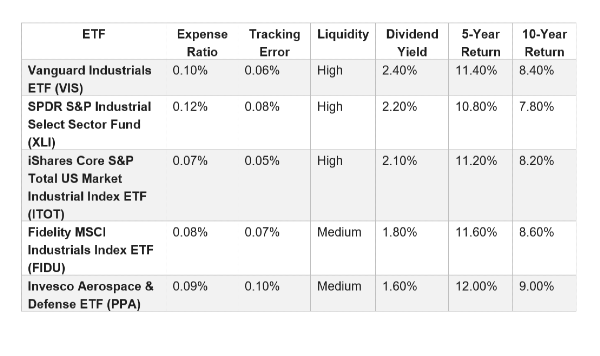
As you can observe, all five exchange-traded funds (ETFs) have exhibited performance over the last five and ten years. However, PPA has surpassed the ETFs in both timeframes. This is likely due to the growth of the aerospace and defense industry in recent years.
In conclusion, industrial ETFs present an opportunity for investors to participate in expanding the sector. These ETFs provide exposure to this sector. They are relatively affordable and easily accessible for investment purposes. If you are considering investing in the industry, it would be worth exploring one of the ETF options.
Read more about Industrial Stocks in our ongoing sector series:
The Top Industrial Stocks
Are Industrials a Good Investment?
The Best Industrial ETFs
How do you Evaluate Industrial Stocks?
What is the Manufacturing Sector
Industrial Stocks with Dividends
Why Invest in Manufacturing Stocks
Important Manufacturing Sector Ratios
Why are Industrial Stocks Doing Well
What Affects the Industrial Industry?
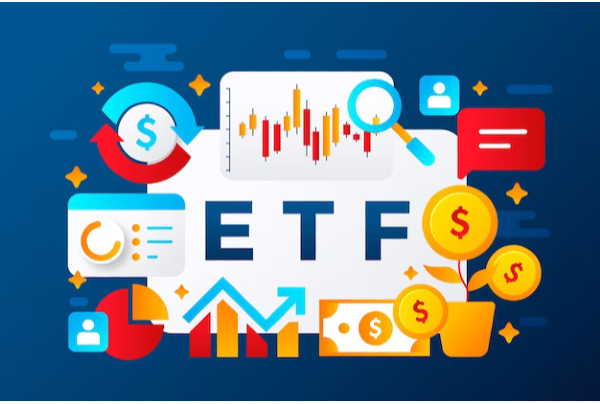

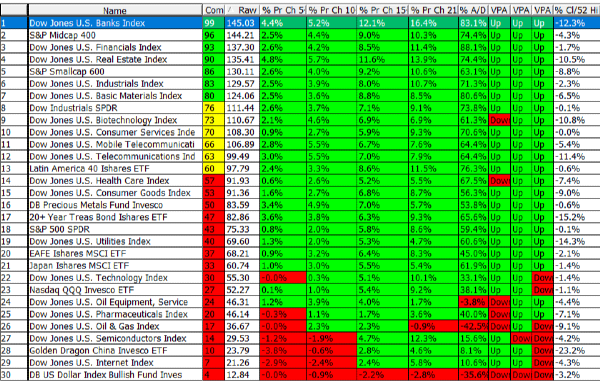
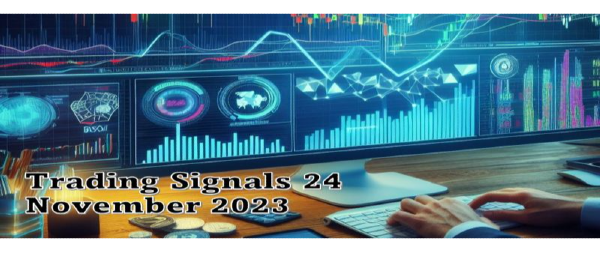
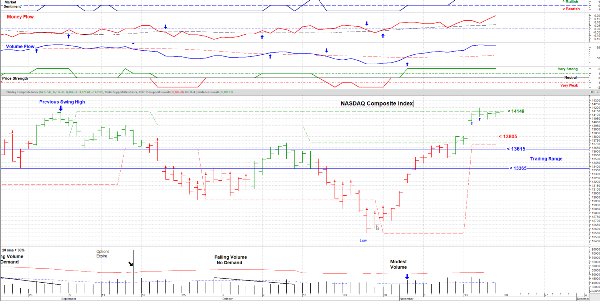



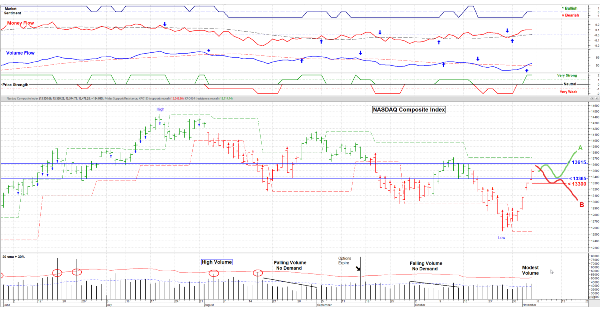




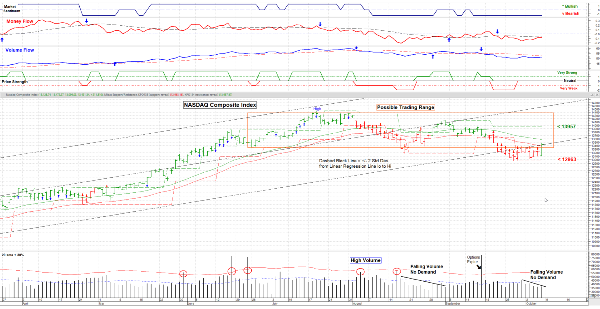
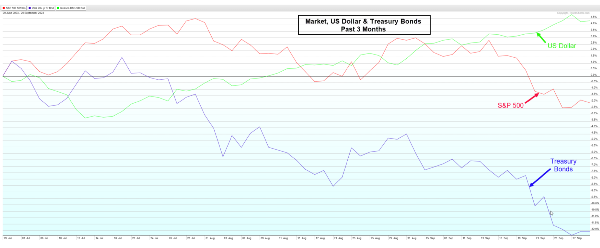


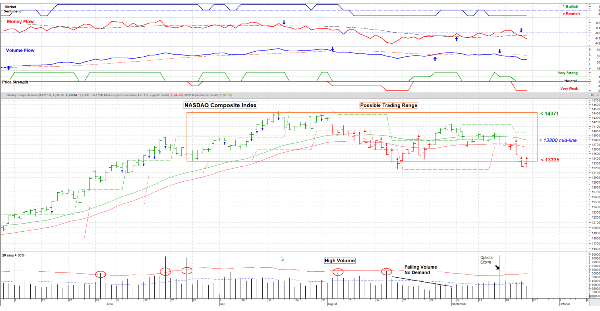
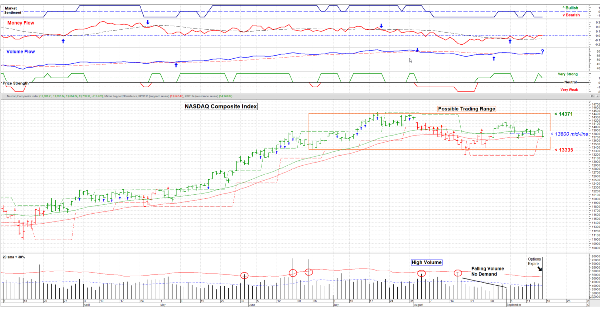
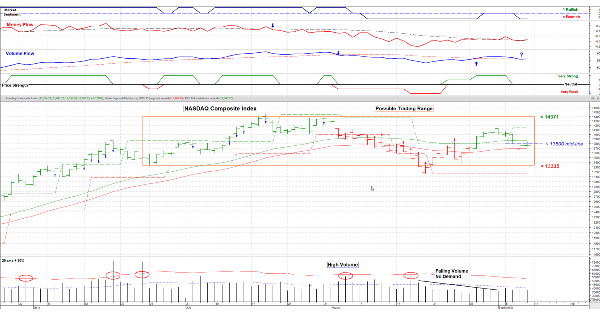










Expertise Provided by Mark Robertson
Investing in the sector can be a move; one way to do it is through industrial ETFs. These investment vehicles allow you to track various stocks, exposing you to the sector. The best part is that these ETFs are affordable and accessible for investors of all levels, making them a great option.
This article will explore some of the top ETFs available in the market. Additionally, we will address queries about these ETFs, including their definition, the ones out there, and whether any industry-specific options are worth considering. Some best Utility ETFs are also included in it.
Given the plethora of ETFs, choosing the one might seem daunting. However, here are some standout options that you should consider;
Vanguard Industrials ETF (VIS)
The VIS is an ETF that closely follows the S&P 500 Industrial Index. It is widely recognized as one of the best ETFs available and comes with a low expense ratio of just 0.10%.
The stock chart you provided illustrates the Vanguard Industrials ETF (VIS) performance between November 23 and November 25, 2023. Starting at $203.29 on November 23, it concluded at $203.96 on November 25, showing an increase of 0.67% over the three-day period.
The stock ended the day higher than its 50-day moving average, indicating a trend. The Momentum RSI (MRSI) indicator stands at 70.27, which suggests that the stock has been relatively stable over the three days, with a value of $204.28 and a lowest value of $203.29, indicating a neutral market condition.
After analyzing the aspects of VIS, the stock will likely stay within a range shortly. If you're considering investing, it would be wise to wait for the store to surpass $204.28 or drop below $203.29 before deciding whether to buy or sell.
SPDR S&P Industrial Select Sector Fund (XLI)
XLI represents another exchange-traded fund (ETF) closely tracking the S&P Industrial Select Sector Index. It resembles VIS, albeit with an expense ratio of 0.12%.
Upon reviewing the chart, it becomes evident that XLI maintained a trading range over three days, reaching as high as $106.54 and dipping to a low of $106.07. Interestingly, the stock concluded above its 50-day moving average, indicating an outlook. However, it remains below its 200-day moving average, signaling some sentiment. The Momentum RSI (MRSI) indicator currently stands at 71.30, surpassing the threshold of 50 but falling short of 70.
Based on analysis, XLI is in a good state for now. To decide on investing, it would be wise for investors to await either a breakthrough above $106.54 or a substantial decline below $106.07 before establishing a position.
iShares Core S&P Total US Market Industrial Index ETF (ITOT)
ITOT is an exchange-traded fund (ETF) that provides exposure to the sector by tracking the S&P Total US Market Industrial Index. This ETF comprises stocks of market capitalizations, including oversized, mid-, and small-cap companies. An attractive feature of ITOT is its expense ratio of 0.07%.
The iShares Core S&P Total US Industrial Sector ETF (ITOT) has been experiencing a trend since the beginning of November. The 50-day and 200-day moving averages show a decline, and the Momentum RSI (MRSI) indicator is below 70. These indications suggest that the stock will continue its decline in the future. Therefore, investors should exercise caution before considering purchasing this ETF.
Fidelity MSCI Industrials Index ETF (FIDU)
FIDU is an ETF focusing on companies tracking the MSCI World Industrials Index. It comprises a range of stocks and boasts a low expense ratio of 0.08%.
Looking at the chart, it's evident that FIDU experienced trading over ten days with a high point of $57.28 and a low point of $56.59. Notably, the stock closed above its 50-day and 200-day moving averages, indicating market sentiment. The Momentum RSI (MRSI) indicator currently stands at 70.79, surpassing the level of 50 but remaining below the level of 70.
Based on analysis, FIDU is currently following a short-term trend. Investors are advised to consider purchasing FIDU when it dips below its 50-day moving average.
Invesco Aerospace & Defense ETF (PPA)
PPA is an exchange-traded fund (ETF) focusing on aerospace and defense industries. It mirrors the performance of the S&P Aerospace & Defense Select Industry Index, which comprises stocks from companies operating in this sector. Additionally, it boasts an expense ratio of 0.09%.
According to the chart, PPA remained within a range, reaching a peak of $87.74 and a low of $87.29 for the two days. Notably, the stock closed above its 50-day and 200-day moving average indicators. The Momentum RSI (MRSI) indicator stands at 74.08, indicating that it is above the level of 50 but still below the level of 70.
Based on analysis, PPA is currently experiencing a trend in the short term. However, since the stock is approaching territory, potential investors should exercise caution before making any purchases at this level.
Which industrial ETF is best?
The suitable industrial ETF for you will vary depending on your investment objectives and your comfort level with risk. VIS or XLI are good choices if you prefer a low-cost, diversified ETF. On the other hand, if you are interested in an industrial ETF, FIDU can be a solid option. PPA may be worth considering if your focus is on a sector industrial ETF.
What is industrial ETF?
Industrial exchange-traded funds (ETFs) are investment vehicles that follow a collection of stocks from companies operating in the sector. This sector comprises businesses engaged in producing and manufacturing goods, including machinery, equipment, and transportation vehicles. By investing in ETFs, individuals can conveniently access this sector's opportunities without the need to select stocks.
Pros of Industrial ETFs:
• Diversification: Industrial exchange-traded funds (ETFs) provide the benefit of spreading investments across a range of companies, which can help mitigate risk. • Cost effectiveness: Investing in industrial ETFs is typically cost-effective due to their low expense ratios, allowing investors to allocate their funds efficiently within the industrial sector. • Transparency: With ETFs, investors enjoy transparency as they can access information about the stocks held within the fund. • Tax advantages: For those in tax brackets, industrial ETFs can offer tax efficiency by optimizing tax obligations while investing.
Cons of Industrial ETFs:
• Sector risks: Investing in ETFs carries the risk of potential volatility as their performance may fluctuate more significantly compared to the overall market.
• Limited upside potential: It's important to note that industrial ETFs might not offer the same growth potential as sectors like technology or healthcare.
• Commodity price sensitivity: Industrial companies often experience the impact of changes in commodity prices, which can directly influence their profitability.
In summary, investing in ETFs can expose investors to the sector. However, it's crucial to be mindful of the associated risks before making any investment decisions.
Here are some additional advantages and disadvantages worth considering when evaluating ETFs;
Additional pros:
• Opportunity for exposure to expansion: Industrial exchange-traded funds (ETFs) have the potential to benefit from economic growth as they are closely linked to the economy.
• Possibility of earning dividend income: Many industrial companies distribute dividends, offering investors a source of income.
Additional Cons:
• Vulnerability to interest rate fluctuations: Industrial companies tend to be sensitive to changes in interest rates, which can impact their borrowing expenses.
• Competition from firms: Industrial companies may face competition from counterparts, leading to potential profit pressures.
What is the largest industrial ETF?
The Vanguard Industrials ETF (VIS) is the leading ETF in size. With assets under management exceeding $100 billion, it has gained popularity among investors. It remains a top choice in the market.
Are there industry-specific ETFs?
Indeed, there are industry exchange-traded funds (ETFs) that you can consider. For instance, you can explore ETFs focusing on aerospace and defense, transportation, or manufacturing sectors. Investing in these ETFs allows you to gain industry exposure without selecting stocks.
Additional Information
Apart from the information mentioned earlier, there are a few factors to consider when selecting an industrial ETF;
1. Expense Ratio: The expense ratio refers to the fee of investing in an ETF. It's advisable to opt for an expense ratio.
2. Tracking Error: Tracking error measures how closely an ETF follows its underlying index. A lower tracking error is preferable.
3. Liquidity: It indicates how easily you can buy or sell an ETF. A liquid ETF will have a bid-ask spread.
4. Dividend Yield: Dividend yield represents the percentage of a company's profits distributed as dividends to shareholders. A higher dividend yield is generally considered advantageous.
Historical Performance
The past performance of an ETF does not guarantee its performance. However, it can provide insights into how the ETF has performed. Below is a table displaying the performance of the five ETFs mentioned above;
As you can observe, all five exchange-traded funds (ETFs) have exhibited performance over the last five and ten years. However, PPA has surpassed the ETFs in both timeframes. This is likely due to the growth of the aerospace and defense industry in recent years.
In conclusion, industrial ETFs present an opportunity for investors to participate in expanding the sector. These ETFs provide exposure to this sector. They are relatively affordable and easily accessible for investment purposes. If you are considering investing in the industry, it would be worth exploring one of the ETF options.
Read more about Industrial Stocks in our ongoing sector series:
The Top Industrial Stocks
Are Industrials a Good Investment?
The Best Industrial ETFs
How do you Evaluate Industrial Stocks?
What is the Manufacturing Sector
Industrial Stocks with Dividends
Why Invest in Manufacturing Stocks
Important Manufacturing Sector Ratios
Why are Industrial Stocks Doing Well
What Affects the Industrial Industry?